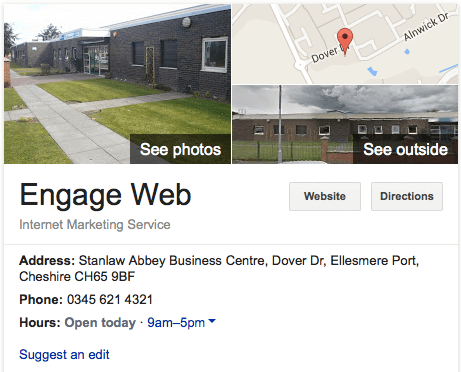If you lived through the ‘80s and ‘90s, you’ll remember that the first reference point if you wanted to find a local business was the phone book or Yellow Pages. This was a big, weighty doorstop of a directory that was so large, the deliverer had to actually call at your door and hand it to you, as it wouldn’t fit through an ordinary letterbox.
These reference points still exist of course, but they’re comparatively lightweight, almost resembling a pocket reference book. In fact, today’s Yellow Pages would be all but useless for its advertised purpose during Christmas 1997.
This reflects not a decline in local business or an increased environmental conscience, but a change in the way we both search for and contact businesses. Let’s imagine, for example, that two people want to know what our office hours are here at Engage Web. One of these people has internet access, but the other doesn’t.
The person without the internet reaches for his trusty phone book, looks under the ‘internet marketing’ or ‘digital marketing’ section, scans the companies beginning with ‘E’, phones us up and asks one of our friendly team what our office hours are, and we tell them it’s 9:00 am to 5:00 pm Monday to Friday.
Nothing wrong with doing that of course, but the other person just Googles ‘Engage Web’…
…and Google brings up everything they need.
The internet is not only a convenient tool for finding a business, but it also lessens our need to contact them by phone. The two primary purposes served by the traditional phone book – finding businesses and contacting them – have both therefore been replaced by the web.
A key reason why today’s telephone directories are much slimmer is that they used to charge companies extra if they wanted a larger placement. The bog standard entry was just one line of text, but some businesses would pay for a full-page advert. Nowadays, few companies would bother, instead preferring to spend their time and money on boosting their online presence.
Companies also used to regularly name themselves with their phone book entry in mind, because it was the first place people turned to when looking for local businesses. Since entries were listed alphabetically, names like ‘1st Choice’, ‘A1’ or ‘Aaron’s’ were common. Today, when most of us head online to find businesses, names like this are not really an advantage.
Modern companies need to consider ‘Googleability’ when naming themselves, and should therefore consider a unique name. Names like ‘A1’ are probably more of a hindrance than a help in 2016, as there are so many of them. Some established names might barely be Googleable at all, as dance-punk band !!! (pronounced ‘chk chk chk’) have discovered.
Another trend is to take two words and combine them into one. This might be most notable with well-known sites like Facebook, YouTube and LinkedIn, but names less readily associated with the internet like TalkTalk, Eventbrite and QuickBooks follow the pattern too. The advent of URLs meant that the space between words became largely superfluous, so many companies now leave it out of their branding to be consistent with their URL.
Traditionalists may yearn to thumb through directories looking for a local company, but the days of doing so look numbered. Indeed, it may not be long before the Yellow Pages becomes the Yellow Page.
- How to find a circular reference on Excel - May 23, 2024
- Five life skills learned from internet marketing - January 3, 2024
- How artificial intelligence can (and can’t) help you write content - September 29, 2023






John Harding liked this on Facebook.